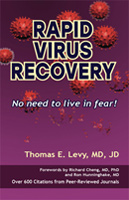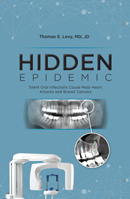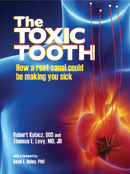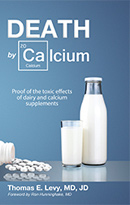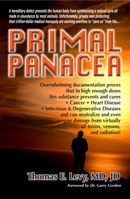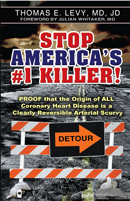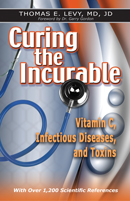Curing Viruses with Hydrogen Peroxide: Can a simple therapy stop the pandemic?
08/21/2020 by Dr. Thomas LevyFOR IMMEDIATE RELEASE
Orthomolecular Medicine News Service, August 21, 2020
Curing Viruses with Hydrogen Peroxide
Can a simple therapy stop the pandemic?
Commentary by Thomas E. Levy, MD, JD
(OMNS August 21, 2020) In an earlier OMNS article, a number of highly effective therapies for COVID-19 were itemized and briefly discussed, along with supporting scientific references for the facts that were presented. [1] Many of these therapies, alone or in combination with other approaches, have been consistently seen to cure cases of COVID-19, including many cases that were very advanced and even ventilator-dependent. Yet in spite of all of this information, most physicians, researchers, and the medical literature they generate in abundance continue to ignore this information. And it is now clear that some medical centers and the physicians that represent them will actively suppress the dissemination of this information. Conscientious physicians who speak out to the contrary face losing their hospital-based employment, and many also face challenges to their licenses from state medical boards. Regardless of where you or your physician stands on the validity of any therapy, the primary fact that dictates whether a therapy is embraced depends almost entirely on how much money can be generated for the doctor, the hospital and the pharmaceutical company.
In addition to the obvious differences between the money generated for natural therapies versus prescription drugs, there are physicians who continually cry out for all clinical therapies to be validated with "large, prospective, double-blind, and placebo-controlled clinical trials." Truth be known, very few prescription drugs meet this standard. It is important to note that such trials can only be performed by deep-pocketed drug companies or well-endowed research institutes capable of spending enormous amounts of money (often in the millions of dollars). And neither the research institute nor the drug company has the slightest interest in establishing that expensive drugs can be undercut by any of many effective natural remedies. Finally, it should be understood that enrolling very sick patients in trials that have a placebo group is highly unethical when the therapy has already been clearly established to have a positive clinical impact with no significant toxicity. These large clinical trials are really only appropriate to establish how effectively a drug relieves disease symptoms along with determining the incidence and degree of toxicity that it can produce.
Stopping the Pandemic: Inhalation Medicine
The only way to stop the COVID-19 pandemic, as well as to prevent or deal with any such future calamities, is to apply a therapy that is highly effective, completely nontoxic, readily available, and inexpensive. Lacking any one of these four aspects of a potential therapy can cripple how well a pandemic can be promptly and readily resolved.
Inhalation Medicine is a growing branch of medicine that is providing a wide array of new approaches to disease via the inhalation of therapeutic agents into the lungs. Although the application of agents via inhalation has been around since ancient times, the current and widely available technology of inexpensive and highly efficient nebulization devices is rapidly expanding this form of medicine application.
Nebulization is a well-established procedure utilized to deliver any of a wide variety of therapeutic agents into the lungs to combat infection and/or improve lung function in different medical conditions. [2-4] Patients with chronic lung disease and asthma are regularly treated with this procedure. The therapeutic agents are dissolved in a solute (often water or saline solution) and converted into a fine mist of such a tiny particle size that it can reach deeply into the lungs. At the same time, such a nebulized agent is also reaching inside the sinuses, along with all the mucosal surfaces in the nasopharynx and oropharynx. Nebulization therapy is being used effectively for the prevention of pneumonia in patients supported on mechanical ventilation. [5] It is also being increasingly used as an additional option for the delivery of different drugs in patients on mechanical ventilation. [6]
COVID-19 infections, along with the common cold, influenza, and any other respiratory viral infection, are ideally addressed by nebulizing agents that inactivate viruses and kill cells already having a high virus content. While early intervention with an appropriately prescribed and nebulized pathogen-killing agent can serve as an effective monotherapy, it is best to regard all of the applications of Inhalation Medicine as natural adjuncts to other indicated medical therapies for both respiratory conditions as well as for various chronic diseases. While respiratory infections are most accessible by nebulization, many other conditions in the lungs and the rest of the body can be positively impacted by the nebulization of appropriate agents.
It is important to note that this article seeks only to describe a therapy that is highly effective, potentially accessible to any person on the planet, exceptionally inexpensive, and easily available without requiring a prescription. I am not trying to convince the reader to just nebulize HP and do nothing else. It is vital to your general health as well as to overcome COVID-19 to take all of the quality supplements available and affordable to you, including, but definitely not limited to, vitamin C, magnesium, vitamin D, vitamin K2, iodine, zinc, and quercetin. [1] That said, however, prompt HP nebulization can be expected to reliably eradicate respiratory and pharyngeal pathogens and to facilitate the rapid recovery from any infection entering the body through the nose or mouth, including COVID-19.
Hydrogen Peroxide (HP) Biochemistry and Physiology
Many people, including physicians, simply regard HP as an effective disinfectant capable of decontaminating surfaces from contaminating pathogens. They recognize its ability to readily clean and disinfect open wounds as well. In fact, HP has been documented to readily kill all pathogens against which it has been tested, including viruses, bacteria, and fungi. Some pathogens require a higher concentration and a longer exposure time to HP in order to be killed, but they all have been documented to succumb. [7-10]
Like all other agents capable of causing oxidation, HP is toxic in high enough concentrations. However, at the low concentration levels to be discussed in this article, it is completely nontoxic. Even the best pharmaceutical drugs can harm and kill. Over 100,000 Americans die annually due to the toxicity of prescription drugs properly dosed and administered for various conditions. Nobody dies from hydrogen peroxide applied at its established, therapeutic concentrations.
A tiny nonionic molecule, HP readily crosses the membranes of both pathogens and cells in the body. HP is literally present everywhere in the body, both inside the cells and in the extracellular spaces. [11] The normal physiology of the body involves the continual generation of HP throughout the body. Furthermore, HP molecules are actually quite stable and not prone to oxidize surrounding molecules except when certain local conditions exist, as is present in acute and chronic infections. [12] Pathogens have high levels of reactive (unbound) iron inside them, and it is a process of electron donation from iron to HP inside the pathogen-filled cells or inside the invading pathogens themselves that forms the highly destructive oxidizing agent known as hydroxyl radical. Hydroxyl radicals quickly kill pathogens and also readily destroy cells that are already heavily laden with pathogens.
Because of this ability of HP to generate hydroxyl radical in iron-filled pathogens, it serves as a primary way in which the body mounts a natural defense against infection. In every sense of the word, HP is the body's natural antibiotic. The generation of HP has been shown to increase in the presence of greater degrees of infection and inflammation. [13] Activated phagocytes responding to a site of infection and inflammation naturally generate massive amounts of HP into the extracellular space to help deal with the pathogens. [14,15] Very interestingly, phagocytes also have high concentrations of vitamin C, which can help supply the electrons to HP via the free iron present to form hydroxyl radicals. Also, vitamin C is known to help generate increased amounts of extracellular HP for better pathogen-killing. [16.17]
Also, as one might expect from a natural defense mechanism, the by-products of HP that result from its normal metabolism and from its anti-pathogen effects are completely nontoxic, in striking contrast to virtually all prescription agents utilized to treat infections. When HP has been metabolized, only water and oxygen remain. One can actually think of HP as being an effective storage form of oxygen, waiting for the right microenvironment in which to release it. This means that HP can kill pathogens and improve the health of the microenvironment in which the pathogens were killed at the same time.
In a normal, uninfected state, pulmonary epithelial cells, the cells lining the airways of the lungs, naturally excrete and express HP. [18] This process finely coats HP onto the exposed side of these cells, protecting the lungs from the new pathogens contained in every breath. Of note, when inflammation and infection are already present, increased amounts of HP are found in the exhaled breath. [19] This is consistent with a natural compensatory mechanism to help contain the infection and keep it from spreading. HP has also been documented to be present in human urine, where it can also provide its anti-pathogen effects. [20] The ubiquitous and essential role of HP in the body is further reflected in its vital role as a signaling molecule in both the intracellular and extracellular spaces, directly influencing and modulating multiple metabolic processes. [21]
In addition to its presence throughout the body, both inside and outside the cells, HP is present in drinking water, rain water, and sea water. It is also assimilated from the diet. The relationship of HP to water and oxygen in general is also reflected in the fact that it can be spontaneously generated in microdroplets of water, with tinier droplets resulting in greater degrees of production. [22,23]
HP Nebulization for Respiratory Infections, Including COVID-19
The search for an effective, nontoxic, available, and inexpensive respiratory virus therapy could end with HP. In particular, HP nebulization would be the HP application of choice in this pandemic. Intravenous HP infusions of the correct concentration and administered properly are also highly effective against viruses and other infections, but this application of HP will not satisfy the availability requirement needed to quell a pandemic.
As should now be apparent from the role that HP already plays in the body in protecting against infection, the nebulization of HP into the sinuses, nasal passages, throat, and lungs is just a straightforward and quite elegant way to augment the body's natural expression of HP to combat infection and inflammation. Individual sensitivities to inhaled HP can vary widely, but a 3% concentration or far lower (even as low as 0.1%) will reliably kill pathogens where they encounter the HP. When the pathogens have been killed, sensitivity to the inhaled HP increases and it is then less well-tolerated, since the mucosal lining cells can be irritated by the HP when it no longer has pathogens upon which to exert its killing/oxidative impact. The only "toxic" effects of inhaled HP consist of minor degrees of nasal and throat irritation that rapidly resolve upon termination of the nebulization. [24]
Also, while HP is known to kill all pathogens, it is especially effective against viruses encountered via respiratory routes, which is the case with all cold and influenza-causing viruses, including coronaviruses. Large studies examining this clinical impact of HP nebulization remain to be done, but it is already clear that this therapy is effective for many patients, extraordinarily safe, and of inconsequential cost (less than ten cents of HP per nebulization). There is everything to be gained and nothing to be lost in applying HP in this manner. It does not need to displace traditional therapies, as it can augment the positive impact of any other clinical intervention. There are no traditional therapies that nebulized HP works to counteract in any way.
For early onset and treatment of coronavirus:
Regular off-the shelf 3% HP can be utilized. Preparations of greater pharmacological purity can be obtained if desired (food grade). Food grade HP typically comes in concentrations greater than 3% and must be appropriately diluted. HP in a concentration greater than 3% should never be nebulized.
For most adults, the 3% concentration can be utilized in the nebulization chamber undiluted. This optimizes the degree and rapidity of the antiviral and anti-pathogen effect. However, don't be reluctant to dilute the 3% solution if not easily tolerated. Note that the first few partial inhalations might not be well-tolerated, but these initial inhalations effectively "coat" the mucous membranes with the HP mist, and subsequent inhalations are not only well-tolerated but relaxing. However, never continue inhaling any agent that makes breathing more difficult.
When a runny nose or slightly sore throat is already present, it is recommended that 5- to 15-minute nebulization sessions be undertaken several times daily or until a symptomatic relief is realized. Many individuals report significant improvement only a few hours after the first one or two treatments. However, it would be advisable to persist in these treatments several times daily for at least 24 to 48 hours after you feel everything is completely normal in your sinuses, nose, and throat to assure a complete resolution of the infection.
For some, the 3% concentration results in too much stinging/burning in the nose or soreness in the throat. Such individuals can dilute with water until they find their highest comfortable concentration. Anybody can tolerate a low enough dilution of the HP solution with water. Additional water can always be added until the nebulization is completely comfortable. Lower HP concentrations can be utilized with clearly beneficial effect, but a positive clinical response can be expected to occur more rapidly with the higher concentrations.
Prevention/Maintenance
As it is a completely nontoxic therapy, HP nebulization can be done as often as desired. If done on a daily basis, a very positive impact on bowel and gut function will also often be realized, as killing the chronic pathogen colonization present in most noses and throats stops the 24/7 swallowing of these pathogens and their associated toxins. When done in the absence of clinical infection, just 1 to 2 minutes of slow, deep breathing with the nebulizer should serve as an excellent preventive measure.
If daily prevention is not a practical option, be ready to nebulize whenever you feel you have had a significant pathogen exposure, as when somebody sneezes in your face or when you finally get off of the plane after a long flight. Don't wait for initial symptoms. Just nebulize at your first opportunity. Prevention is always easier than remediation.
Of great practical significance, HP nebulizations can also be expected to rapidly resolve a positive COVID-19 test after killing the virus in the nose and nasophyrynx, and quarantine periods can then be shortened, often by many days.
1. Levy T (2020) COVID-19: How can I cure thee? Let me count the ways. OMNS Vol. 16, No. 37. http://orthomolecular.org/resources/omns/v16n37.shtml2. Shirk M, Donahue K, Shirvani J (2006) Unlabeled uses of nebulized medications. American Journal of Health-System Pharmacy 63:1704-1716. https://pubmed.ncbi.nlm.nih.gov/16960254
3. Martin A, Finlay W (2015) Nebulizers for drug delivery to the lungs. Expert Opinion on Drug Delivery 12:889-900. https://pubmed.ncbi.nlm.nih.gov/25534396
4. Lavorini F, Buttini F, Usmani O (2019) 100 years of drug delivery to the lungs. Handbook of Experimental Pharmacology 260:143-159. https://pubmed.ncbi.nlm.nih.gov/31792683
5. Karimpour H, Hematpour B, Mohammadi S et al. (2020) Effect of nebulized eucalyptus for preventing ventilator-associated pneumonia in patients under mechanical ventilation: a randomized double blind clinical trial. Alternative Therapies in Health and Medicine Feb 21. Online ahead of print. https://pubmed.ncbi.nlm.nih.gov/32088670
6. McCarthy S, Gonzalez H, Higgins B (2020) Future trends in nebulized therapies for pulmonary disease. Journal of Personalized Medicine 10:E37. https://pubmed.ncbi.nlm.nih.gov/32397615
7. Dockrell H, Playfair J (1983) Killing of blood-stage murine malaria parasites by hydrogen peroxide. Infection and Immunity 39:456-459. https://pubmed.ncbi.nlm.nih.gov/6822428
8. Heckert R, Best M, Jordan L et al., (1997) Efficacy of vaporized hydrogen peroxide against exotic animal viruses. Applied and Environmental Microbiology 63:3916-3918. https://pubmed.ncbi.nlm.nih.gov/9327555
9. Berrie E, Andrews L, Yezli S, Otter J (2011) Hydrogen peroxide vapour (HPV) inactivation of adenovirus. Letters in Applied Microbiology 52:555-558. https://pubmed.ncbi.nlm.nih.gov/21418259
10. Goyal S, Chander Y, Yezli S, Otter J (2014) Evaluating the virucidal efficacy of hydrogen peroxide vapour. The Journal of Hospital Infection 86:255-259. https://pubmed.ncbi.nlm.nih.gov/24656442
11. Halliwell B, Clement M, Ramalingam J, Long L (2000) Hydrogen peroxide. Ubiquitous in cell culture and in vivo? IUBMB Life 50:251-257. https://pubmed.ncbi.nlm.nih.gov/11327318
12. Halliwell B, Clement M, Long L (2000) Hydrogen peroxide in the human body. FEBS Letters 486:10-13. https://pubmed.ncbi.nlm.nih.gov/11108833
13. Caffarelli C, Calcinai E, Rinaldi L et al. (2012) Hydrogen peroxide in exhaled breath condensate in asthmatic children during acute exacerbation and after treatment. Respiration 84:291-298. https://pubmed.ncbi.nlm.nih.gov/23018317
14. Root R, Metcalf J, Oshino N, Chance B (1975) H2O2 release from human granulocytes during phagocytosis. I. Documentation, quantitation, and some regulating factors. The Journal of Clinical Investigation 55:945-955. https://pubmed.ncbi.nlm.nih.gov/1123431
15. Root R, Metcalf J (1977) H2O2 release from human granulocytes during phagocytosis. Relationship to superoxide anion formation and cellular catabolism of H2O2: studies with normal and cytochalasin B-treated cells. The Journal of Clinical Investigation 60:1266-1279. https://pubmed.ncbi.nlm.nih.gov/199619
16. Levine M, Padayatty S, Espey M (2011) Vitamin C: a concentration-function approach yields pharmacology and therapeutic discoveries. Advances in Nutrition 2:78-88. https://pubmed.ncbi.nlm.nih.gov/22332036
17. Pei Z, Wu K, Li Z et al. (2019) Pharmacologic ascorbate as a pro-drug for hydrogen peroxide release to kill mycobacteria. Biomedicine & Pharmacotherapy 109:2119-2127. https://pubmed.ncbi.nlm.nih.gov/30551469
18. Hidvegi M (2020) Inhaled nebulized sodium pyruvate use in COVID-19 patients. The Israel Medical Association Journal 22:278. https://pubmed.ncbi.nlm.nih.gov/32378817
19. Jobsis Q, Raatgeep H, Schellekens S et al. (1998) Hydrogen peroxide in exhaled air of healthy children: reference values. The European Respiratory Journal 12:483-485. https://pubmed.ncbi.nlm.nih.gov/9727806
20. Varma S, Devamanoharan P (1990) Excretion of hydrogen peroxide in human urine. Free Radical Research Communications 8:73-78. https://pubmed.ncbi.nlm.nih.gov/2318421
21. Rice M (2011) H2O2: a dynamic neuromodulator. Neuroscientist 17:389-406. https://pubmed.ncbi.nlm.nih.gov/21666063
22. Lee J, Walker K, Han H (2019) Spontaneous generation of hydrogen peroxide from aqueous microdroplets. Proceedings of the National Academy of Sciences of the United States of America 116:19294-19298. https://pubmed.ncbi.nlm.nih.gov/31451646
23. Zhu C, Francisco J (2020) Production of hydrogen peroxide enabled by microdroplets. Proceedings of the National Academy of Sciences of the United States of America 116:19222-19224. https://pubmed.ncbi.nlm.nih.gov/31484759
24. Ernstgard L, Sjogren B, Johanson G (2012) Acute effects of exposure to vapors of hydrogen peroxide in humans. Toxicology Letters 212:222-227. https://pubmed.ncbi.nlm.nih.gov/22677343
More Orthomolecular articles:
11/11/2010 | Vitamin C And The Law
02/14/2012 | Vitamin C Prevents Vaccination Side Effects; Increases Effectiveness
08/27/2013 | Vitamin C, Shingles, and Vaccination
09/03/2014 | The Clinical Impact of Vitamin C:
My Personal Experiences as a Physician
05/31/2019 | Curing Polio with Magnesium: The tip of the iceberg?
10/25/2019 | Reboot Your Gut: Optimizing Health and Preventing Infectious Disease
01/29/2020 | Vaccinations, Vitamin C, Politics, and the Law
07/18/2020 | COVID-19: How can I cure thee? Let me count the ways
08/21/2020 | Curing Viruses with Hydrogen Peroxide: Can a simple therapy stop the pandemic?
05/10/2021 | Hydrogen Peroxide Nebulization and COVID Resolution: Impressive Anecdotal Results
06/21/2021 | Resolving Long-Haul COVID and Vaccine Toxicity: Neutralizing the Spike Protein
10/18/2021 | Canceling the Spike Protein: Striking Visual Evidence
12/11/2021 | Vitamin C and Cortisol: Synergistic Infection and Toxin Defense
02/01/2022 | How COVID Helped Me Regain Good Health
05/11/2022 | The Restoration of Vitamin C Synthesis in Humans
06/01/2022 | Monkeypox Infection - To Fear or Not to Fear?
09/08/2022 | Atherosclerosis is a Non-Healing Wound
01/05/2023 | Myocarditis: Once Rare, Now Common
02/04/2023 | Resolving Colds to Advanced COVID with Methylene Blue
03/10/2023 | Resolving Persistent Spike Protein Syndrome
07/31/2023 | The Toxic Nutrient Triad
09/27/2023 | Persistent Spike Protein Syndrome: Rapid Resolution with Ultraviolet Blood Irradiation
10/12/2023 | Schizophrenia Is Chronic Encephalitis...and Niacin Cures It
11/03/2023 | Heart Failure or Therapy Failure? Toxins Cause Cardiomyopathy
12/17/2023 | Root Canals Cause Breast Cancer-Frequently
Article also available at Orthomolecular Medicine News Service
OMNS free subscription link http://orthomolecular.org/subscribe.html
OMNS archive link http://orthomolecular.org/resources/omns/index.shtml


